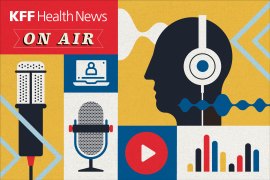NIH Scientific Meetings Scratched As New Administration Moves In
It is unclear how long meetings and study sessions will be put on hold, but some fear a delay could affect research and grant funding. Separately, an executive order is in the works to withhold funding for “gain-of-function” research on viruses.
Stat:
Trump Administration Abruptly Cancels Scientific Meetings, Panels
A flurry of scientific gatherings and panels across federal science agencies were canceled on Wednesday, at a time of heightened sensitivity about how the Trump administration will shift the agencies’ policies and day-to-day affairs. (Oza, 1/22)
NBC News:
HHS Official Halts CDC Reports And Health Communications For Trump Team Review
Late Wednesday, the NIH responded in a statement: “HHS has issued a pause on mass communications and public appearances that are not directly related to emergencies or critical to preserving health. “This is a short pause to allow the new team to set up a process for review and prioritization.” The pause took effect immediately and will last through Feb. 1. (Edwards and Lovelace Jr., 1/22)
CBS News:
Who Is In Charge Of The CDC Right Now? Nobody Knows For Sure
The Centers for Disease Control and Prevention is operating without an acting director, multiple health officials confirm to CBS News, leaving the agency responsible for defending the U.S. against emerging pandemics and responding to health emergencies without a clear chain of command. A leadership vacuum atop the CDC is unprecedented. Under previous administrations, including the first term of President Trump, officials made sure either to immediately appoint their pick for the position or decide during the transition on whom would assume the top post in an acting capacity. (Tin, 1/22)
Also —
The Wall Street Journal:
Trump Order Seeks To Stop Virus Research That Critics Have Linked To Covid
The Trump administration is preparing an executive order that would halt federal funding, at least temporarily, for a risky and controversial kind of research into viruses that makes the pathogens more dangerous or contagious. The goal of the order would be to stop scientists with U.S. funding from conducting “gain-of-function” research on viruses that could endanger human health, people familiar with the plans said. (Subbaraman and Whyte, 1/22)
Stat:
Trump Executive Order On Only Two Sexes Refuted By Scientists
During his inauguration speech Monday, President Trump promised to make America binary again. “It will henceforth be the official policy of the United States government that there are only two genders, male and female,” he said. Within hours, he had signed an executive order to that effect, asserting a new legal definition of sex that strips federal recognition of the gender identity of some 1.6 million trans and nonbinary Americans. (Molteni, 1/23)
Military Times:
Trump’s Federal Hiring Freeze Raises Fears About VA Medical Care
Congressional lawmakers this week expressed concern that President Donald Trump’s new federal hiring freeze could hurt operations at Veterans Affairs medical centers by complicating efforts to fill critical health care specialties. But whether the executive order even applies to those posts remains unclear. Trump’s pick to lead VA told lawmakers Tuesday that he is still examining the new rule, but he’s optimistic it will not adversely impact veterans’ care. (Shane III, 1/22)
KFF Health News:
What To Know About Trump’s Executive Orders On US Health Care
From rolling back drug pricing policies to limiting gender-affirming care, President Donald Trump signed several health-related executive orders in the first hours of his second presidency. Here’s a roundup of the changes and what they mean. This slide presentation first appeared on KFF Health News’ Instagram account. If you enjoyed this story from the KFF Health News social team, follow us on Instagram @kffhealthnews. (Lofton, 1/22)
KFF Health News:
Trump’s Early Health Moves Signal Intent To Erase Biden’s Legacy. What’s Next Is Unclear
President Donald Trump’s early actions on health care signal his likely intention to wipe away some Biden-era programs to lower drug costs and expand coverage under public insurance programs. The orders he issued soon after reentering the White House have policymakers, health care executives, and patient advocates trying to read the tea leaves to determine what’s to come. The directives, while less expansive than orders he issued at the beginning of his first term, provide a possible road map that health researchers say could increase the number of uninsured Americans and weaken safety net protections for low-income people. (Appleby and Armour, 1/23)






